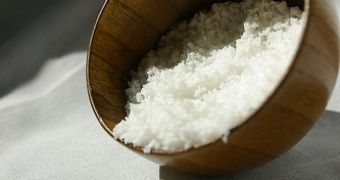If adolescents would lower their daily salt consumption by 3 grams, they would decrease the risks of high blood pressure, heart disease and stroke in adulthood, concluded a research funded by the American Heart Association.
Teenagers eat more salty foods every day now, reaching an average of 9 grams of salt – or 3,800 milligrams of sodium, per day, more than any other age group, according to the researchers.
The American Heart Association recommends a maximum daily quantity of sodium of 1,500 milligrams, for most Americans, which equals almost 3,55 grams of salt.
Nearly 80 percent of the salt consumed every day comes from processed or prepared foods, out of which 35 percent can be found in bread, cereals and pastries.
Kirsten Bibbins-Domingo, PhD, MD, lead author of the study and associate professor of medicine and epidemiology at the University of California, San Francisco, said that “the hidden places of salt in our diet are in breads and cereals, canned foods and condiments, and of course fast foods.
“Most of the salt that we eat is not from our salt shaker, but salt that is already added in food that we eat.”
The biggest salt contribution to the teenagers' diet seems to be pizza, according to data from the National Center for Health Statistics.
The team or researchers carried out a very complex computer model analysis, for which they projected a nationwide 3-gram reduction in dietary salt from processed foods consumed by adolescent boys and girls.
Bibbins-Domingo, also co-director of the UCSF Center for Vulnerable Populations, said that “reducing the amount of salt that is already added to the food that we eat could mean that teenagers live many more years free of hypertension.
“The additional benefit of lowering salt consumption early is that we can hopefully change the expectations of how food should taste, ideally to something slightly less salty.”
She added that lowering the salt consumption with even one gram per day, would lower the systolic blood pressure by 0.8 mm Hg, and so, by “reducing the salt in the teenage diet from an average of 9 grams to 6 grams would get teenage boys and girls to appropriate levels of salt intake.”
The computer model suggested that by lowering the salt that adolescents eat every day by 3 grams, there would be a 44 to 63 percent decrease in the number of hypertensive teens and young adults, which means between 380,000 and 550,000 individuals.
At age 35 to 50, the number of hypertensives would have decreased by 30 to 43 percent, or by 2.7 to 3.9 million people.
By the time the teenagers are 50 years old, there would be considerable health benefits, like a 7-12 percent reduction in coronary heart disease (120,000 to 210,000), an 8-14 percent lower heart attacks rate (36,000 to 64,000), a 5-8 percent reduction in stroke (16,000 to 28,000), and a 5 percent to 9 percent lowering in death from any cause (69,000 to 120,000).
Bibbins-Domingo said that food manufacturers should continue to lower the salt levels in their products, in cooperation with local, state and federal regulatory agencies.
She added that it's a very good thing that many big companies have already joined the National Sodium Reduction initiative and have agreed to work on lowering the salt level in their products, voluntarily.
The study was presented at the American Heart Association’s Scientific Sessions 2010.

 14 DAY TRIAL //
14 DAY TRIAL //